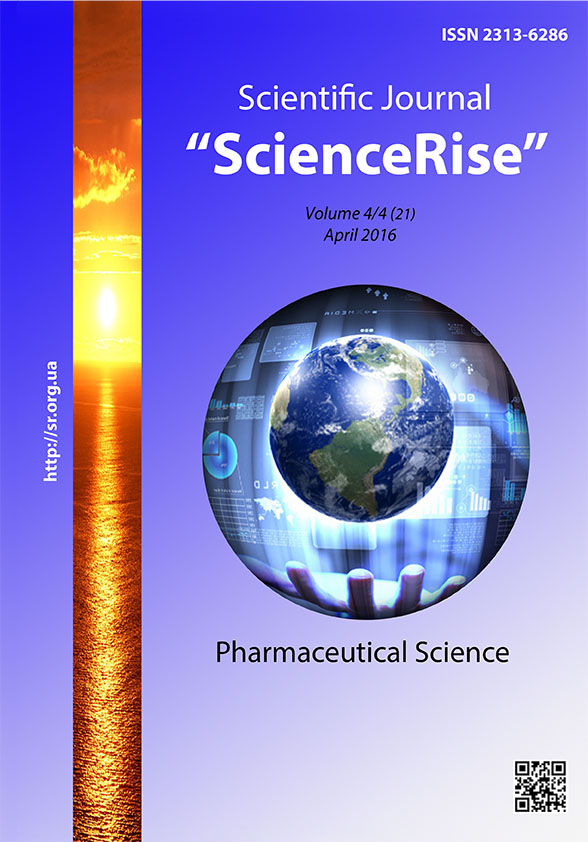Rationale for creating legislative definide range drugs in accordance with the protocol pharmacists and clinical protocols of medical care for pharmacies and pharmac family pharmacy of common type institutions of family medicine
DOI:
https://doi.org/10.15587/2313-8416.2016.66967Keywords:
pharmacy, family pharmacy, family pharmaceutical sales representative (pharmacist), range of medicines, pharmacist protocols, standardized protocols of careAbstract
The purpose of our work was to prove the reasons for the creation of a normatively stated range of medicines based on the principles of evidentiary pharmacy in accordance with the unified clinical protocols of medical assistance and the protocols of pharmaceutical sales representative (pharmacist) for family and general pharmacy stores.
Methods. The structural-logical and content analysis, surveys under the business name “Family pharmacy”, interaction between family pharmacies and institutions of family healthcare, the results of our own investigation were used as the methods of our research.
Results. For the first time in Ukraine, the article, provides a report on the results of investigating and summarizing analysis of the protocols of a pharmaceutical sales representative (pharmacist) based on the legal and regulatory framework and the clinical protocols of medical assistance, along with necessary regulatory coordinated structure for the creation of a required range of medicines used in the family pharmacy at the institutions of family medicine.
Conclusions. The need is stressed to create specialized medical facilities based on the principles of family pharmacy, to take measures for further re-organization of the structure of general pharmacies that serve the institutions of family medicine. We also stress the necessity for developing an adequate legal and regulatory framework, instruction documents and methodological guidelines for its further effective functioning, determination of the essential range of medicines in accordance with the unified clinical protocols a family doctor or pharmaceutical sales representative uses
References
Good pharmacy practice in Europe. Pharmaceutical Group of the European Union PGEU (1998). Geneva: Community pharmacists, 9.
Kudrja, A. V. (2015). Osnovni tendencii' monitoryngu rozvytku simejnoi' medycyny v Ukrai'ni. Simejna medycyna, 4, 6–11.
Campbell, J. L. (2001). Age, gender, socioeconomic and ethnic differences in patients’ assessment of primary health care. Quality in Health Care, 10 (2), 90–95. doi: 10.1136/qhc.10.2.90
Matjuha, L. F., Nadutyj, K. O., Kondratjuk, N. Ju. (2013). Stan modernizacii' pervynnoi' medychnoi' dopomogy v Ukrai'ni. Zhurn. Ukrai'na Zdorov’ja nacii', 2, 76–83.
Parnavs'kyj, B. L., Jackova, G. Ju. (2001). Nuzhen ly Ukrayne semejnыj provizor. Provyzor, 4, 5.
Vlasenko, I. O., Bullah, A., Davtjan, L. L. (2013). Vyvchennja asortymentu likars'kyh zasobiv dlja miscevogo likuvannja grybkovyh urazhen', shho uskladneni keratozom. Farmac. zhurn., 6, 15–20.
Zakon «Pro likars'ki zasoby» (1996). Verhovna Rada Ukrai'ny; vid 04.04.1996 r.; № 123/96-VR. Available at: http://www.moz.gov.ua/ua/portal/zn_19960404_123_.html
Kotvic'ka, A. A., Karlo, V. V. (2014). Pidhody do optymizacii' farmacevtychnogo ta medychnogo zabezpechennja hvoryh na psoriaz. Farmac. zhurn., 6, 18–22.
Institute of Medicine. Crossing the Quality Chasm: A New Health System for the 21 st Century (2001). Washington DC: National Academy Press.
Da Vanzo, J., Dobson, A., Koenig, L., Book, R. (2005). Medication Therapy Management Services: A Critical Review. American Pharmacists Association, 17. Available at: https://www.accp.com/docs/positions/commentaries/mtms.pdf
Good pharmacy practice (GPP) in community and hospital pharmacy settings (1996). Geneva: WHO, 8. Available at: http://apps.who.int/medicinedocs/documents/s21088en/s21088en.pdf
Zbirnyk normatyvno-dyrektyvnyh dokumentiv z pytan' pervynnoi' medyko-sanitarnoi' dopomogy ta zagal'noi' likars'koi' praktyky / simejnoi' ta zagal'noi' likars'koi' praktyky / simejnoi' medycyny (2004). Kyiv, 101.
Mnushko, Z. N., Alekkerova, N. V., Pestun, Y. V. et. al (2012). Ynstytut semejnogo provizora (farmacevta) v strukture upravlenyja lekarstvennoj terapyej pacyenta. Farmacevt praktyk, 10, 63–64.
Mnushko, Z. M., Shevchenko, I. A. (1997). Formuvannja optymal'nogo asortymentu likars'kyh preparativ za pokaznykom shvydkosti ruhu. Visnyk farmacii', 2 (16), 88–91.
Chernobrovyj, V. M., Melashhenko, S. T., Fishhenko, L. V. (2015). Osnovni pytannja reformuvannja systemy ohorony zdorov’ja na zasadah zagal'noi' praktyky – simejnoi' medycyny: dosvid roboty komunal'nogo zakladu «Centr pervynnoi' medyko-sanitarnoi' dopomogy №1», m. Vinnycja. Simejna medycyna, 4, 14–16.
Pestun, I. V. (2012). Optymizacija upravlinnja asortymentom likars'kyh zasobiv u farmacevtychnyh organizacijah. Kyiv, 15.
Gyrina, O. M., Grishylo, P. V., Lemzjakova, T. G. et. al; Moskalenko, V. F., Gyrina, O. M. (Eds.) (2007). Simejna medycyna. Kn. 1. Organizacijni osnovy simejnoi' medycyny. Kyiv: Medycyna, 392.
Downloads
Published
Issue
Section
License
Copyright (c) 2016 Микола Семенович Пономаренко, Алла Василівна Кабачна, Олексій Станіславович Соловйов, Сабіна Валеріївна Аугунас, Володимир Олександрович Борищук

This work is licensed under a Creative Commons Attribution 4.0 International License.
Our journal abides by the Creative Commons CC BY copyright rights and permissions for open access journals.
Authors, who are published in this journal, agree to the following conditions:
1. The authors reserve the right to authorship of the work and pass the first publication right of this work to the journal under the terms of a Creative Commons CC BY, which allows others to freely distribute the published research with the obligatory reference to the authors of the original work and the first publication of the work in this journal.
2. The authors have the right to conclude separate supplement agreements that relate to non-exclusive work distribution in the form in which it has been published by the journal (for example, to upload the work to the online storage of the journal or publish it as part of a monograph), provided that the reference to the first publication of the work in this journal is included.

